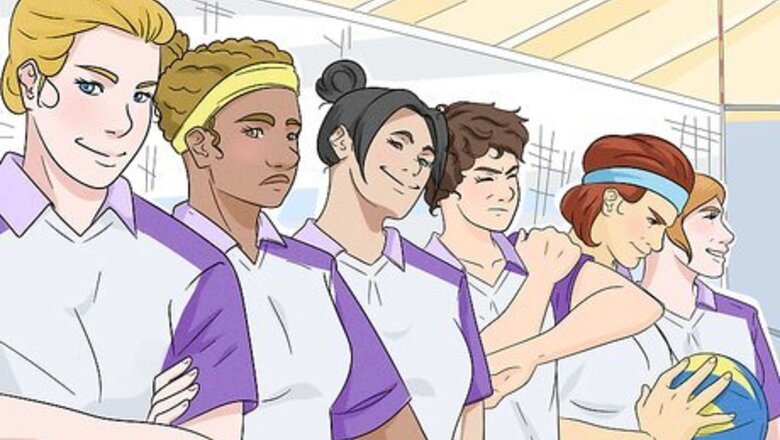
views
Playing the Game
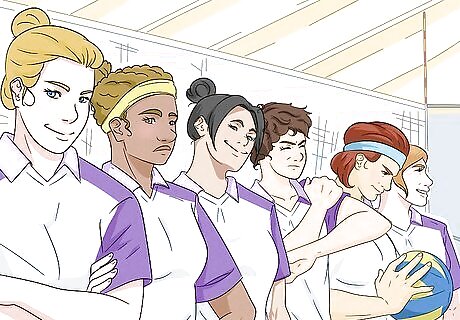
Choose your players. Ideally, you want at least 6 players per team for a competitive game. However, if you're playing with a group of friends, keep the same number of players on each side. You should have 2 rows of players, with the first row closest to the net and the back row closest to the rear boundary of the court. The player in the back right corner will serve the ball. You can rotate players around the court so that you will have a new server for each service game. If you are rotating players out, rotate clockwise -- looking at the net, the player closest to it on the right side would rotate out, allowing for many players to play.
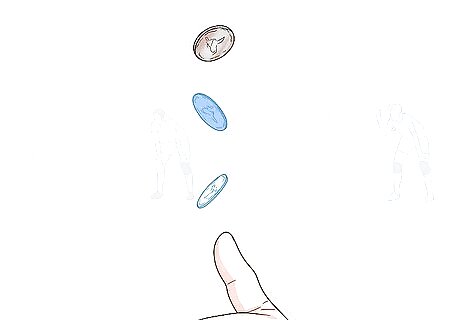
Determine which team will "serve" the ball first. Toss a coin or form an agreement to find out who will begin the game.

Serve the ball from behind the line at the back of the court. If you serve from in front of the line it will be a point for the other team. This is known as a foot fault. The ball has to go over the net (but it can touch), and it has to land within the court for the serve to be good. The player on the right-hand side at the back of the court serves. Each player will only receive one service attempt per serve rotation; you may serve as many times as you can get the ball in the other teams court. The ball is good even if it lands on a line.
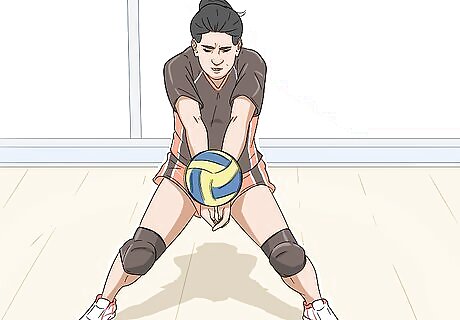
Return the ball if you're on the receiving team. Thus the rally has begun! A typical play will be bump, set, spike -- but as long as it goes over within three hits, it's good. Technically, you can hit the ball with any part of your body so long as the ball does not come to a rest. Players may go over the lines, but the ball may not. If a player on your team hits it out of bounds, you may run to retrieve it -- successfully so if it doesn't touch the ground.
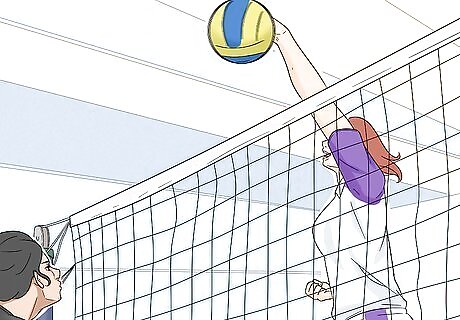
Continue hitting the ball back and forth across the net until a fault happens. This could be because of any one of the following: The ball hits the ground. This can cause the serving team to score 1 point for their team. If the ball hits the ground on the side of the serving team, then the other team has the opportunity to serve. If the ball hits the ground on the side of the receiving team, then the serving team can serve again. The point is awarded to the team that did not allow the ball to hit the ground. The ball goes out of bounds. The team that hits the ball out of bounds loses the point. Someone touches the net. If a player on one team touches the net, then the opposing team picks up a point. Someone's foot goes under the net. When this happens, the opposing team receives the point. Someone hits the ball 2 consecutive times. Players can't strike the ball twice in a row, unless a strike is in the block. A block does not count as a touch. A team hits the ball 4 or more times without sending it over. 3 is the maximum. Catching the ball without bumping it on the acceptance from play. Letting the recipient team receive the ball bump from anything besides their arms or hands can cause the serving team to pick up a point. Returning the ball without allowing the ball to cross over the top of the net will score one point for the serving team.

Serve the ball again. The team that won the last point gets to serve the ball. If you're rotating, rotate now. If your team has the ball, it's common for the rows to back up a bit. The idea here is to get ready for an attack. If you don't have the ball, move forward. The idea instead here is to make the attack. Teams who produce an error or send the ball out-of-play will automatically send the ball over to the other team to serve. No extra score must be added to the "new" serving team. NO penalty may be given in any situation where the ball touches the net then goes over to the other side to be played. The ball continues to be live and playable (unless it comes back towards the recipient team on the volley).
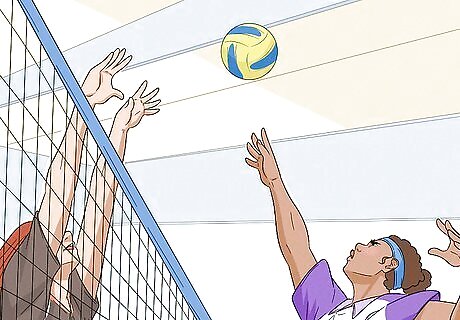
Continue playing until you reach a threshold. You can decide how many points you will allow for each game. For instance, you can start a new game when a team earns 15 points. Recent rules state that regulation games go to 25 points, with the third game (in a set of three) going to 15. Sometimes, games may take the form of ending with a certain time limit but this must be agreed upon - generally, this time limit will be eight minutes, but may be longer or shorter dependent on situation for the game. A standard match is three games long. Each team should switch sides at the start of a new game. The losing team during each service should have the chance to serve in the next game of the match. A game must be won by two points. 25-26 will not cut it; it must be 25-27. Because of this, close games can go on much longer.
Learning the Shots

Learn the basic stance. When you're not serving, it's common to take on a basic volleyball stance. Your feet should be placed slightly wider than your shoulders, your weight should be forward on your toes, and your knees bent. Make sure your hands are palms-up and resting comfortably on your knees. Unlike the opinions of many, volleyball is an intense sport. During a match, players can go the equivalent of a couple of miles in distance.
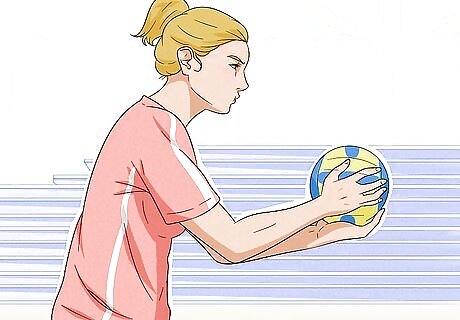
Practice your serve. A basic serve gets the ball over the net and into the other court to start the rally. This can be done anywhere behind the serve line. A serve that immediately scores a point (only touches the server's hands) is referred to as an "Ace." Most commonly, this is done by hand, fist or arm. More experienced players can try an overhand serve: Toss the ball in front of you. Raise your dominant hand in the air. Bend your elbow to bring your hand closer to your shoulder. Straighten your elbow and strike the ball with the outside of your hand. Less experienced players can serve underhanded. Hold the ball in your hand out in front of you. Make a fist and pull your dominant hand down and to the side. Your elbow should be slightly bent, and your thumb should be stretched across your fingers. Strike the ball at waist level using the front side of your fist. The ball should hit your fist against your bent thumb and index finger.
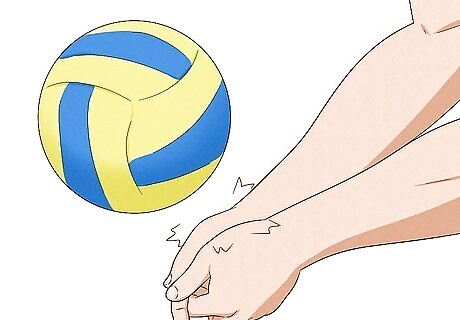
"Bump" the ball. This is the most commonly used shot for returning a serve. Ideally, you would "pass" it to the setter on the team. The bump is the first in a 3-move play. Make a fist with your left hand and wrap your right hand around it. Both thumbs should be flat against the top of your hands with your thumbnail facing upward. Rotate your elbows until the flat side of your forearm is facing upward. Your arms should be straight out in front of you at a slightly downward angle, and your elbows should be locked. Move so that the ball is directly in front of you. Stand with your feet shoulder-width apart and wait until the ball is at the same level as your waist. Allow the ball to strike your forearms about 2 to 6" (5 to 15 cm) above your wrists. When the ball makes contact with your forearms, push up with your legs and angle your "platform" toward your target.

Practice setting. Typically, you will not set the ball on the return of serve. Instead, you will use the set to get the ball into the air so that another player can bump it or spike it. Hold your hands in the air and make a triangle window you can see through. Place your feet shoulder-width apart, and bend your legs slightly. Hit the ball with your fingertips when the ball reaches eye level. Push upward with your legs as your strike the ball. If you slap it with the palm of your hand, in a real game, that will be called out for "lifting," like you actually caught the ball and just lifted it back up.

Know how to spike. This is also known as the "attack." Approach the ball and lift your dominant hand. Your hand should be curved into the shape of the ball, and your elbow should be bent. Jump up and strike the ball with your palm. Reach as high as you can for maximum power. The ball should travel over the net but sharply downward so that it is difficult for the other team to return it.

Be ready to block. For the (three) players at the net, this is used to stop an attack, or spike. There are two types of blocks: An offensive block aims to keep the ball on the opponent's side of the court. The timing must be exactly right to jump up, predict the trajectory of the ball, and slam it back onto the opponent's side. Ideally, it sends the ball straight to the floor. A defensive, or soft, block is used just to stop the power behind the ball to make it easier to send back. The ball hits the blocker's palm, rolls along their fingertips (losing power) and is received by another player. A block does not count as one of the three hits allotted to a side to get the ball over the net.
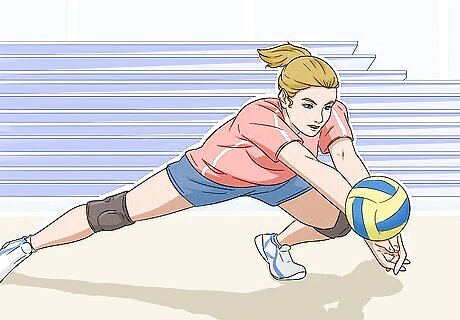
Dig. This is mainly a term for a dive -- a spectacular play where the player saves the ball right before it hits the ground. It involves a great level of reflex and agility. In diving, players land on their chests with their arms stretched out. It is very important to do this safely as injury is likely if done wrong. Seasoned players employ a rolling technique to minimize the risk of injury.
Employing Strategy
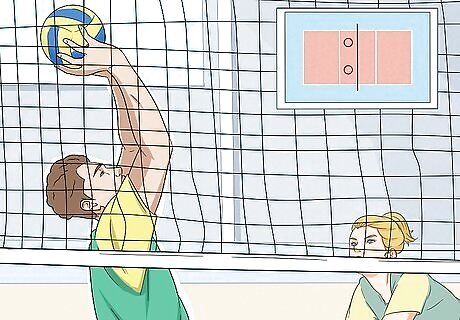
Have designated setters. Setting is a definite skill and maintains the offensive for the team. They must be able to operate in tandem with the hitters and place the ball exactly where it needs to be for the attacker to strike the ball effectively. They must be swift and agile in addition to having technical accuracy when it comes to launching the ball. With a bad set, the ball is going nowhere. Just be warned: setters have a lot of restrictions. When they are in the front row they can attack and hit the ball at their will, but, when they are back row, they may not attack any ball that is above the net.

Use a "libero." If you're getting up there in skill, using a libero may be a strategy your team wants to employ. This is not counted as a substitution -- this player wears a different color. This player receives the attack or serve and must have cat-like reflexes. They are a "defensive specialist." They usually replace the middle blocker or center when they are supposed to rotate into the back row. If you have a player that is great at receiving attacks, put 'em in as the libero. That literally means "free," as in they're free to sub in and out as often as they want. However, they cannot play in the front row.
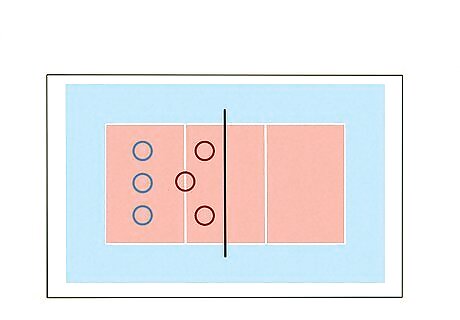
Employ middle, opposite and outside hitters. Each designation of hitter has their strong points. Look at your team and see who falls into what category: Middle hitters must perform fast attacks and be decent blockers. They are playing offense and defense constantly. Opposite hitters (or right-side hitters) are a back-up setter and primarily work on defense. They must provide a good block at all times because they are essentially blocking the opposing team's outside, or strong-side, hitter. Outside hitters should be the most consistent hitter on the team as that's generally where all the serves go. They are also often employed if a first pass goes astray from the middle.
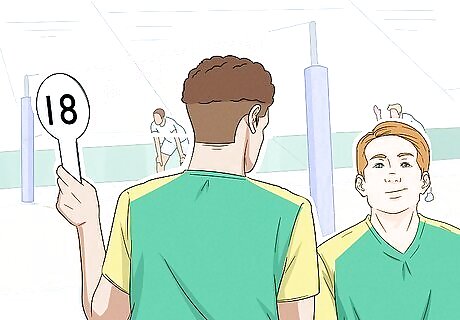
Substitute players. Though some leagues will allow unlimited substitutions, international rules say that you can have a maximum of 6 (not including the libero). You can also pull in a serving specialist or a defensive specialist (not the same thing has a libero) if your team is lacking in serving or defense skills.
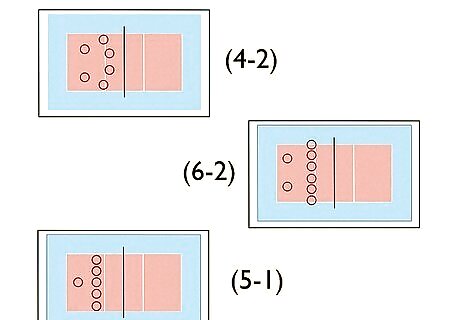
Consider different formations. We'll be assuming you're working with 6 players here. If you're not, adapt your number of players and their skills to other various formations. However, with six, there are generally three to choose from (the numbers refer to positions, not to number of players): 4-2 formation. This has four hitters and two setters. Generally speaking, the setters position themselves on the right; they are the two front attackers. This is generally only used in beginner's play. 6-2 formation. This is where a player comes up from the back and acts as a setter. The front row is all poised to attack. All players will be hitters at some point or another. 5-1 formation. This has only one player as a setter, regardless of where they are positioned in the rotation. Obviously then, there are sometimes 2 and sometimes 3 attackers in the front row. The setter can then change up their strategy as they rotate and even just dump the ball lightly over the net at times. It's very setter-centric!

Always try to pay attention! The ball could come at you at any time. Be prepared and stay on your guard. If the ball is thrown at you without warning, shield your face from the hit with your hands.
Setting Up Your Own Game
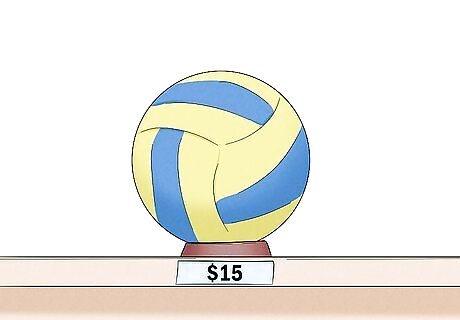
Purchase a volleyball. The best volleyballs are made of leather or synthetic leather. Also, the ball should have an inner bladder made of rubber. For indoor volleyball, choose a ball that is well-pressurized. Also, look for a ball that is a light uniform color. For outdoor or beach volleyball, choose a brightly colored volleyball that will be easy to see in the sunlight.
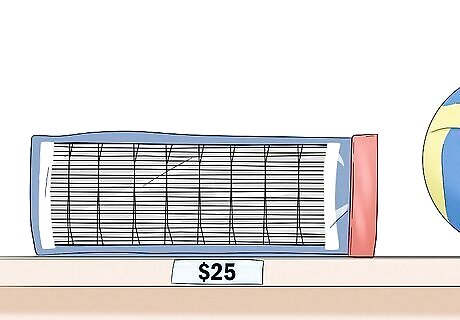
Buy a net. Make sure that the supports for your net are made of galvanized metal or treated wood. Also, consider padding the poles to protect the players. An official net measures 32 feet (9.75 m) long and 39" (1 m) wide. For men, it comes in at 7 feet (2.1 m) 11 5/8 in (2.43 M) high and for women, it tops out at 7 feet (2.1 m) 4 1/8 in (2.24 m). If you're playing outdoors, dig a hole at least 3' (about 1 m) deep for the poles. If you want your court to be permanent, pour concrete into the holes before you install the poles.
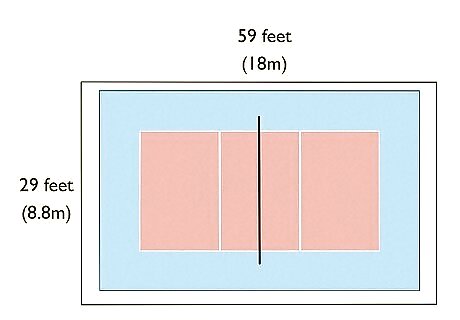
Measure your court. An official volleyball court is 29 feet (8.8 m) 6" (9 m) wide and 59 feet (18 m) (18 m) long. Use spray paint or bright nylon tape to mark the boundaries of your court. The lines should be approximately 2" (5 cm) wide. Alternatively, you can use the line markers that came with the net that you purchased. Your court should face north and south as opposed to east and west. This orientation ensures that no team is ever looking directly into the sun. If you're playing an informal game, you can simply mark the boundaries with some shoes or any other items that you have laying around. Don't worry about exact measurements; the point is to have fun while you're playing.
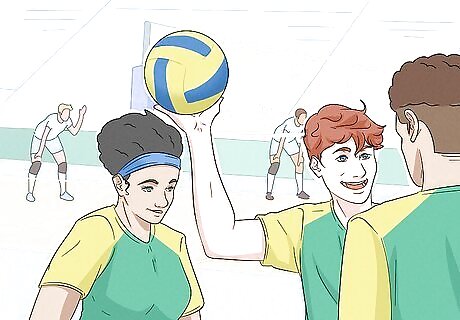
Gather your friends. Now that you have all the necessary equipment, get a group together! Volleyball can be played with two people, but it's more fun with a dozen or so. Take the number that you have and figure out your formation -- how will you rotate (if you rotate at all) and account for skill? If you have an odd number, you can either have the odd man out rotate sides, join the weaker team, or rotate one individual acting as a referee or scorekeeper. Or they could be the designated libero and pop around at will!


















Comments
0 comment